|
The Long Island Rail Road “Neither rain, nor snow, nor gloom of night kept this train from making its appointed back-and-forth runs throughout the day.”
|
|
The Long Island Rail Road “Neither rain, nor snow, nor gloom of night kept this train from making its appointed back-and-forth runs throughout the day.”
|
| 1914 LIRR System Map - Suffolk County | |||||||||||

|
|||||||||||
| Greenport Scoot | |||||||||||
|
Once shuttle service began in the early 1970s between Hicksville and Ronkonkoma using push-pull service, the unofficially-named single-car “Greenport Scoot” ran a shuttle from Ronkonkoma to Greenport Monday to Friday service only June 26, 1972 to June 30, 1981 final run was the time period. It consisted of several cars pulled by one engine and operated in lieu of Jamaica to Greenport train 204 (eastbound) and Greenport to Jamaica train 211 (westbound). January 18, 1988 at the completion of the Hicksville-Ronkonkoma Electrification is when the "Sandwich Train" which was two coaches along with two MP15 locomotives at each end began the Ronkonkoma-Greenport Scoot services for all trains every day - the equipment was replaced around the year 2000 by the current DE30/C3 cars. - Research: Mike McEnaney |
|||||||||||
 |
 Timetable 10/07/1974 Scoot Greenport-Ronkonkoma - Archive: RMLI Note: Trains #4200 east and #4211 west Sat & Sun ran through from Jamaica to Greenport. These two trains nonstop between Ronkonkoma and Riverhead. Researcht: Mike McEnaney |
 Greenport Scoot - Engineer Charlie Reid Conductor Bob Emery 4/1973 Photo/Archive: Brad Phillips |
|||||||||
|
If you like a "low-speed" ride east of Riverhead, then you'd have loved a ride I took on train #204/#211 out to Greenport and back in the hot, sweltering days of August, 1972. Two "ping-pong" cars pulled behind an ALCO RS1. No air conditioning. Front doors, rear doors and vestibule doors wide-open. Windows open. Anything to suck in a breeze. Wonderful feeling as you sweated into a wet mass, then had dust and dirt blow in on you from the trackside potato fields, giving you and the seats and everything else inside the car a nice coating. Add to that, the coup de grace: the conductor sitting in the last bench seat of the rear car . . .. smoking a cigar and spitting on the floor between his legs every few puffs. Ahh . . . Main Line railroading at its best! Dave Keller |
|||||||||||
|
Train service used to be substantial on these trains as can be evidenced by the photos below:
|
|||||||||||
|
|
|||||||||||
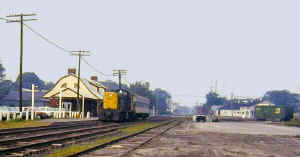 But,
in later years it was simply a 2-car train east in the morning and west in
the afternoon. When
ridership became really low, it ran as a one-car train. I mention that the “Scoot” was
“unofficially-named” because it wasn’t indicated as such on
timetables of the time and the OFFICIAL “Greenport Scoot” ran a
shuttle between Greenport and Eastport over the Manorville-Eastport branch
back in the early days of LIRR service. But everybody referred to it as
the “Scoot” or the “Greenport Scoot” just as they did the shuttle
train that ran for years between Patchogue and Babylon on the Montauk
branch. It, too, was always known as “The Scoot.” But,
in later years it was simply a 2-car train east in the morning and west in
the afternoon. When
ridership became really low, it ran as a one-car train. I mention that the “Scoot” was
“unofficially-named” because it wasn’t indicated as such on
timetables of the time and the OFFICIAL “Greenport Scoot” ran a
shuttle between Greenport and Eastport over the Manorville-Eastport branch
back in the early days of LIRR service. But everybody referred to it as
the “Scoot” or the “Greenport Scoot” just as they did the shuttle
train that ran for years between Patchogue and Babylon on the Montauk
branch. It, too, was always known as “The Scoot.”The “Greenport Scoot” train would lay up in Ronkonkoma yard over the weekend and run east again on Monday morning. As ridership declined, the “Scoot” was relegated to one locomotive and one passenger car. At that time, the train would usually lay up at the end of the Ronkonkoma wye. On occasion, leased locomotives pulled the “Scoot’s” one-car train. LIRR #461 Train #202 "Scoot" eastbound at Riverhead Station 8/27/1973 Archive: Dave Keller |
|||||||||||
|
|
|||||||||||
| The single car Ronkonkoma-Greenport Scoot ran between June 26, 1972 to June 30, 1981 (9 years). BAR #69 came to the LIRR in the Spring of 1974, that summer a former KCS coach, was used as a one car train, before it was two P-54 D's, the change over was in early 1974, then in July 1974 a BAR Engine was assign to this job, the Precisions join in also, in late 1974 or early 1975. In late 1974 or early 1975, the LIRR converted P72 # 2959 to a coach for this job with panels to help keep the car warm. | |||||||||||
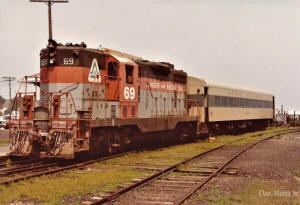 BAR
#69, P72 #2959 "sealed ends" at Greenport 1976 Photo/Archive: Dan
Marra, Sr. BAR
#69, P72 #2959 "sealed ends" at Greenport 1976 Photo/Archive: Dan
Marra, Sr. |
|||||||||||
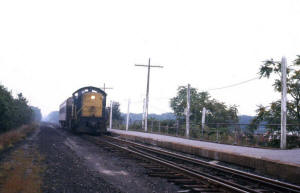 RS1 #461 pulls one-car train #211 westbound as it approaches the station at Medford, NY on August 27, 1973. This train, unofficially referred to in more recent years as the "Greenport Scoot," ran as a shuttle between Ronkonkoma and Greenport. The eastbound portion was train #202 and the westbound portion was train #211. Before it ran as a shuttle, train #211 operated westbound from Greenport straight in to Jamaica. The eastbound portion was train #204 which was eliminated when shuttle service began. In this image note the badly weathered platform lamp posts. The one at right nearest the camera has the station name vertically stenciled on it. At the left is old ballast along the former right-of-way of the passing siding which had been removed ten years earlier. (George Povall collection, Dave Keller archive) |
|||||||||||
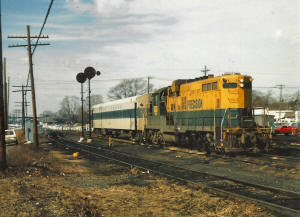 On 11/26/1976, leased PNCX (Precision National Corp) GP9
#980 (EMD, 12/1955, s/n 20833) and "blanked-end" P72 #2959
(Pullman-Standard, 2/1956) are operating #211 (GPT-RON), the weekday
Greenport Scoot. Archive: Mike Boland On 11/26/1976, leased PNCX (Precision National Corp) GP9
#980 (EMD, 12/1955, s/n 20833) and "blanked-end" P72 #2959
(Pullman-Standard, 2/1956) are operating #211 (GPT-RON), the weekday
Greenport Scoot. Archive: Mike Boland |
|||||||||||
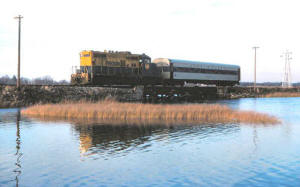 Located
at milepost 91.99 (according to the stationing numbers at least), east of
Southold station on the Main Line (and still within the hamlet of
Southold) is the bridge over Mill Creek, which leads into Hashamomuck Pond
on the far side. On 11/26/1976, leased PNCX (Precision National Corp) GP9
#980 (EMD, 12/1955, s/n 20833) and "blanked-end" P72 #2959
(Pullman-Standard, 2/1956) are operating westbound Train #211 (GPT-RON), the weekday
Greenport Scoot. This would be right about 3:00pm. That P72 had its ends
blanked in late 1974. Photo/Archive: Jeff Erlitz Located
at milepost 91.99 (according to the stationing numbers at least), east of
Southold station on the Main Line (and still within the hamlet of
Southold) is the bridge over Mill Creek, which leads into Hashamomuck Pond
on the far side. On 11/26/1976, leased PNCX (Precision National Corp) GP9
#980 (EMD, 12/1955, s/n 20833) and "blanked-end" P72 #2959
(Pullman-Standard, 2/1956) are operating westbound Train #211 (GPT-RON), the weekday
Greenport Scoot. This would be right about 3:00pm. That P72 had its ends
blanked in late 1974. Photo/Archive: Jeff Erlitz |
|||||||||||
_small.jpg) MP15AC
#152 is pulling P72 # 2925 as the Greenport Scoot eastbound over Mill
Creek trestle at Hashamomuck Pond east of Southold, NY on 7/18/1977 MP15AC
#152 is pulling P72 # 2925 as the Greenport Scoot eastbound over Mill
Creek trestle at Hashamomuck Pond east of Southold, NY on 7/18/1977(Paul J. Templeton photo, Dave Keller archive) |
|||||||||||
|
Ridership must’ve picked up a bit by the mid-late 1980s, because the “Scoot” then consisted of a push-pull train of MP15ac locomotive on the powered end (east end of train) and a FA cab-control unit on the west end, with two P72 rebuilt MU cars sandwiched between. THIS “Scoot” resembles the K-Line “Greenport Scoot” train set that was marketed some years back. |
|||||||||||
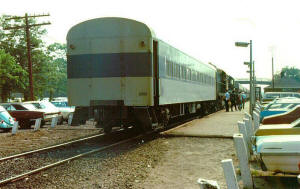 Here the one car “Greenport Scoot” has arrived at the eastern-most end of the Ronkonkoma platform while the westbound push-pull shuttle from Hicksville awaits. Greenport Scoot with LIRR P72 #2959 "sealed end"
coach from Greenport. View W 8/01/1976 |
|||||||||||
|
"The Manual Block signal that controls the block from KO to YA is located east of Knickerbocker Avenue, even to this day...the station technically falls within yard limits thus the sometimes rear end connection or the Scoot sitting across from where the (modern day) MU pulls in is allowed to occur as the station in not located in a block." Riders would get off the Hicksville shuttle and walk forward (eastward) the short distance to the rear vestibule to board the “Greenport Scoot.” The “Scoot” would head off east and the shuttle would return to Hicksville. Info: Dave Keller Leased Precision National GP10 locomotive #980 is coupled to the one-car eastbound Greenport "Scoot" (train #202) and is taking on passengers from the eastbound Hicksville shuttle. View W 3/30/1977 (William Madden Photo-Dave Keller Archive) |
|||||||||||
|
|
|||||||||||
|
|
May 22, 1989 Ronkonkoma Branch
timetable. 9:37 PM - Leave Greenport
|
|
|||||||||
 The
weekend Greenport Scoot is seen eastbound at Schultz-Wading River Road in
Manorville on a clear early-Spring day. 1500's on each end and 2 coaches
were the normal consist, with MU connections at Ronkonkoma to/from points
west. The
weekend Greenport Scoot is seen eastbound at Schultz-Wading River Road in
Manorville on a clear early-Spring day. 1500's on each end and 2 coaches
were the normal consist, with MU connections at Ronkonkoma to/from points
west.April, 1988. Info/Photo/Archive: Jay Bendersky January 18, 1988 at the completion of the Hicksville-Ronkonkoma Electrification is when the "Sandwich Train" which was two coaches along with two MP15 locomotives at each end began the Ronkonkoma-Greenport Scoot services for all trains every day - the equipment was replaced around the year 2000 by the current DE30/C3 cars. Research: Mike McEnaney |
|||||||||||

DE30AC
#412 and 2-car Greenport Scoot coming off the Certified Siding and heading
eastbound into the Ronkonkoma station - 3/1999 Note: The cement company used to build the LIE (Long Island Expressway - I495) Certified Paving Co. |
|||||||||||
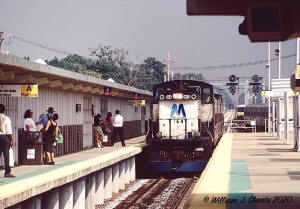 Greenport
Scoot Train 6201 at Ronkonkoma, August 1999. MP15AC 164 2 coaches and
MP15AC 157. View East Greenport
Scoot Train 6201 at Ronkonkoma, August 1999. MP15AC 164 2 coaches and
MP15AC 157. View EastPhoto/Archive: William Skeats |
|||||||||||
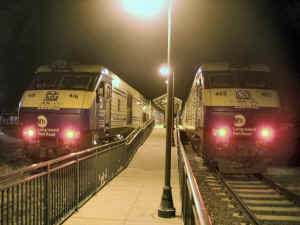 Scoot in Greenport (Last run of the summer
Friday Extra Scoot) 10/09/2009 Photo/Archive: Nick Kudreyko Scoot in Greenport (Last run of the summer
Friday Extra Scoot) 10/09/2009 Photo/Archive: Nick Kudreyko
|
|||||||||||
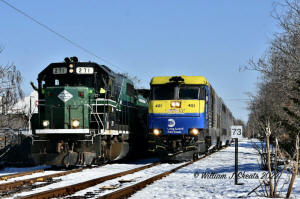 Weekend
Greenport Scoot Train #6293 to Ronkonkoma with DE30AC 401, bilevel 4005,
4030 and DE30AC 412 passing New York & Atlantic
RS 70 at MP73 on LD Siding in Riverhead. 2/06/2021 Note: LD Siding named
for former LIRR Superintendent of Transportation Larry Dixon.
Info/Photo/Archive: William Skeats Weekend
Greenport Scoot Train #6293 to Ronkonkoma with DE30AC 401, bilevel 4005,
4030 and DE30AC 412 passing New York & Atlantic
RS 70 at MP73 on LD Siding in Riverhead. 2/06/2021 Note: LD Siding named
for former LIRR Superintendent of Transportation Larry Dixon.
Info/Photo/Archive: William Skeats |
|
||||||||||
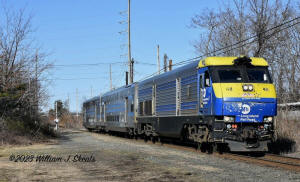 Greenport
Scoot with DE30AC 411 in the lead heading through the former location for
the Holtsville Station. The station closed in 1998 due to low ridership.
3/26/2023 Photo/Archive: William Skeats Greenport
Scoot with DE30AC 411 in the lead heading through the former location for
the Holtsville Station. The station closed in 1998 due to low ridership.
3/26/2023 Photo/Archive: William Skeats |
|||||||||||
|
|
|||||||||||
|
|
|||||||||||
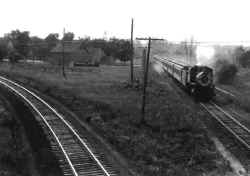
E51sa camelback #4 pulls the "Cannonball" eastbound on the Manorville branch as it approaches the junction with the Montauk branch at Eastport. The view is looking west from atop one of the semaphore signal masts - 1923 James V. Osborne photo, Dave Keller archive. |
|||||||||||
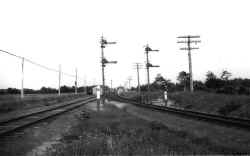
"PT" cabin and block signals looking east from between the Manorville (left) and Montauk (right) branches towards the junction at Eastport - 1921 (J. V. Osborne photo, Dave Keller archive) |
|||||||||||
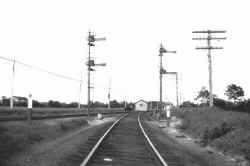
"PT"
cabin and block signals looking east from the Montauk branch towards the
junction at Eastport - 1921. Manorville branch is at the left. (J.
V. Osborne photo, Dave Keller archive) |
|||||||||||
|
Greenport - Bridgehampton Scoot History |
|||||||||||
|
Sag
Harbor Branch The
use of the "Scoot" in round-the-horn service was the reason for
the east leg of the wye being installed at Manorville, allowing trains
(freights included) westbound from Greenport to change direction and head
eastbound towards Eastport and points east, and vice-versa
D52a #95 4-4-0 view SW at Bridgehampton Station. A two coach shuttle train
between Sag Harbor and Greenport, once a day in 1880's. Archive: MTA/LIRR |
|||||||||||

Originally the train that was called the Scoot ran between Greenport and Sag Harbor and return, when there was yet no extension to Montauk. Until Montauk was expanded in 1927, many trains terminated at Amagansett. There were several boarding houses in town where train and engine crews could spend the night until their next run back west. There was even a wye and a 4-stall engine house. This all ended once Montauk expanded and became the actual terminal. Interesting, though, is the fact there was no engine house at Montauk. The timetable says it makes connections with Montauk train 19 at Eastport. It appears the scoot/shuttle continues on to Bridgehampton and Sag Harbor, while Train 19, following on its tail, makes the continued trip to Wainscott, East Hampton and finally Amagansett. Research: Dave Keller Timetable Greenport to Montauk - 10/20/1926 Archive: RMLI
|
|||||||||||
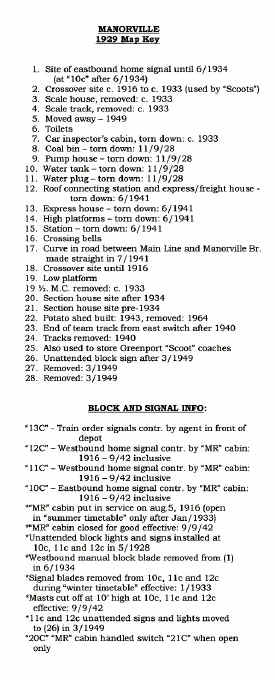 Manorville map key Archive: Dave Keller
|
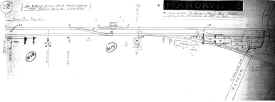 Emery map 1934 Manorville - MP65 to Lanes Rd. Archive: Dave Keller
|
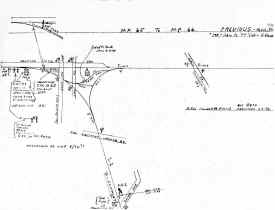 MP65-66 03/1949
|
|||||||||
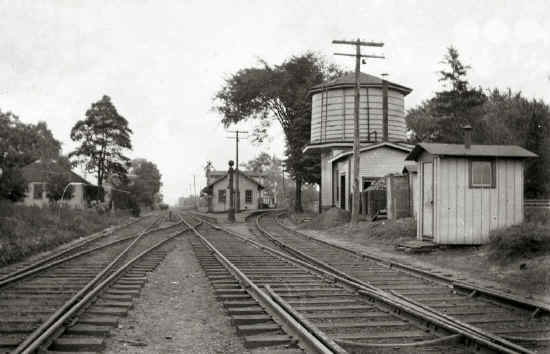 Manorville Jct. Station view E 9/27/1906 Archive: Dave Keller |
|||||||||||
|
Zoom view of 9/27/06 photo showing the station sign says "Manor". It wasn't changed to Manorville until 1907. (Weber - Keller) If the east leg of the wye was not in place, the train would have to pass the station AND block signal westbound, make a reverse move, and back onto the spur. With no place to run the engine around the train, it would have to be pushed all the way to Eastport and beyond . . . not a feasible thing to do for visibility/ safety sake. The
Scoot serviced those customers with an around-the-horn type of run between
Greenport and Bridgehampton via Manorville and Eastport, with a connection
at Bridgehampton with the shuttle to Sag Harbor. Also, passengers
could get off from eastbound Greenport trains and await the eastbound
Montauk train which made the Manorville stop, picking up passengers headed
for the South Shore, but I can't see much of that happening because all
they needed to do was to board the Montauk train coming through there. So
I believe, ridership along that branch was affected by the end of
"Scoot" service sometime in the late 1920's-early 1930's.
Not sure when the "Scoot" stopped running. So,
let's back-step a bit with dating: Most Montauk trains at the
time were being routed via the Central branch between B Tower and Babylon.
Finally,
the spur to Eastport was taken out of service on December 27, 1949. I
guess the LIRR just felt they had two branches connecting the Main Line
with the south shore (Montauk/Springfield branch at Hillside and Central
branch between "B" tower and Babylon) and didn't need to
maintain yet another. The war was over (1945) and Camp Upton closed
for good, so circular routing of trains to and from the camp was no longer
necessary and nobody was anticipating a third world war that would require
the camp to be opened for a third time. Again, this is all conjecture on my part, based upon dates of events and upon prior LIRR actions.
A veteran engineer told me the RR was making a big issue about how much
scrap $ they would get for the rails they tore up. They were quick to tear
up the line. Ridership ended many years before the branch was shut down. |
|||||||||||
|
|
|||||||||||
|
Gas Car Shuttles |
|||||||||||
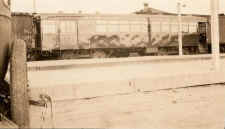 J. G. Brill gas car
(“doodlebug”) #1134 at the designated Sag Harbor platform at the station
– Bridgehampton, NY – 1927. These gas cars were very convenient to
short-line or shuttle operations in that one car could be used to carry both
passengers and mail/express/baggage, with a crew of 2: conductor and
engineer, and they ran on what was then inexpensive gasoline. It
eliminated the need for a steam locomotive, tender loaded with coal, combine
car and a full crew of engineer, fireman, conductor and trainman/brakeman.
They were the forerunner of the BUDD Rail Diesel Car. J. G. Brill gas car
(“doodlebug”) #1134 at the designated Sag Harbor platform at the station
– Bridgehampton, NY – 1927. These gas cars were very convenient to
short-line or shuttle operations in that one car could be used to carry both
passengers and mail/express/baggage, with a crew of 2: conductor and
engineer, and they ran on what was then inexpensive gasoline. It
eliminated the need for a steam locomotive, tender loaded with coal, combine
car and a full crew of engineer, fireman, conductor and trainman/brakeman.
They were the forerunner of the BUDD Rail Diesel Car. |
|||||||||||
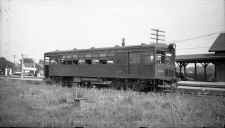 A later view of J.
G. Brill gas car (“doodlebug”) #1134 at the designated Sag Harbor
platform at the station – Bridgehampton, NY – 8/14/38. View
looking southeast. Depot at right. This designated platform was
accessed by a track branching off the Sag Harbor branch track north of the
Montauk branch Main, so the shuttle never had to enter the Main and never
ran the risk of a collision or fouling the Main. A later view of J.
G. Brill gas car (“doodlebug”) #1134 at the designated Sag Harbor
platform at the station – Bridgehampton, NY – 8/14/38. View
looking southeast. Depot at right. This designated platform was
accessed by a track branching off the Sag Harbor branch track north of the
Montauk branch Main, so the shuttle never had to enter the Main and never
ran the risk of a collision or fouling the Main.
|
|||||||||||
|
|
|||||||||||
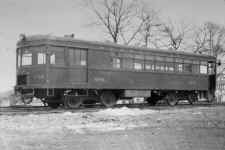 PRR-leased gas car
#4744 is seen laying up at the wye at Wading River, NY in January, 1932.
The shuttle ran between that station and Port Jefferson, where a special
lay-up track was built on the east side of the depot building. This
branch extension between Port Jefferson and Wading River was abandoned in
1938. PRR-leased gas car
#4744 is seen laying up at the wye at Wading River, NY in January, 1932.
The shuttle ran between that station and Port Jefferson, where a special
lay-up track was built on the east side of the depot building. This
branch extension between Port Jefferson and Wading River was abandoned in
1938.(George G. Ayling photo) |
|||||||||||
|
|
|||||||||||
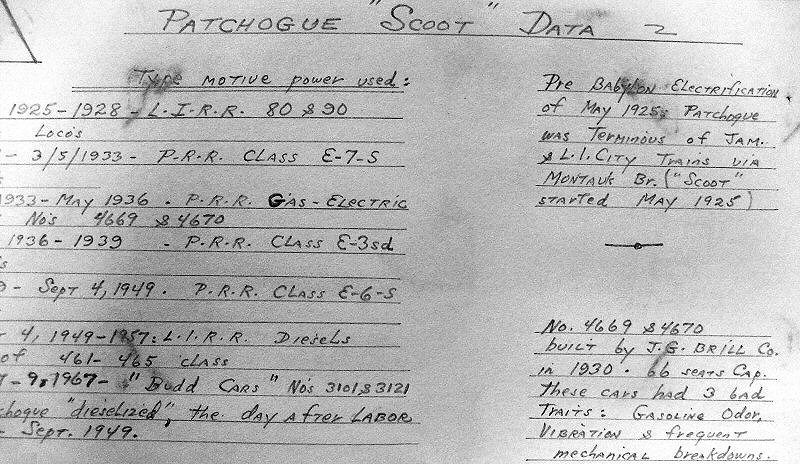 Babylon - Patchogue Scoot Data 5/1958 (Emery-SUNY Stony Brook) |
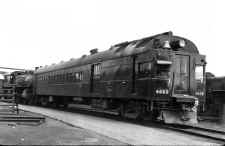 PRR leased gar car #4669 at Morris Park Shops 5/20/1934 Archive: Dave Keller
|
||||||||||
|
It's possible that line
(Emery Scoot data above) reads "__, 1957-9, 1967." 1957 could very well have been the start of RDCs in
Patchogue Scoot service. For the 2 years prior to that, they were run all over.
I have images shot at Mineola, Hicksville, Ronkonkoma, Riverhead, Greenport,
Oyster Bay, Southampton and Patchogue, but not in Scoot service. Also fan
trips in 1956 and early 1947. Dave Keller |
|||||||||||
 |
 Montauk Branch timetable - Scoot Mon-Sat Scoot to Speonk Sat only 9/11/1949 - Archive: RMLI |
 Montauk Branch timetable - Scoot Sun-Holidays 9/11/1949 - Archive: RMLI |
|||||||||
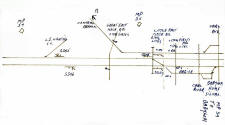 MP34 to Babylon |
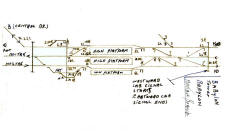 Babylon Tower Area |
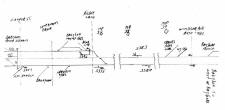 Babylon to Bay Shore |
|||||||||
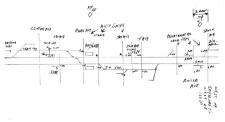 Bay Shore to Islip |
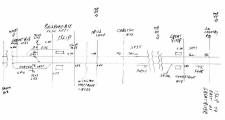 Islip to Great River |
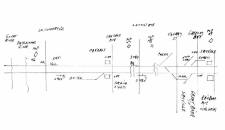 Great River to Sayville |
|||||||||
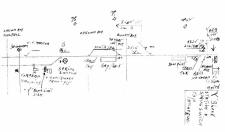 Y Block to Patchogue Yard Limit |
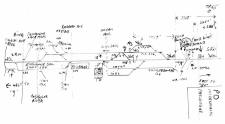 Patchogue |
1950 drawings by Jim Boerckel Archive: Dave Morrison
|
|||||||||
 Babylon-Patchogue Scoot RDC-1, 2 boarding westbound at Patchogue Station View NE 11/1960 Archive: Dave Keller |
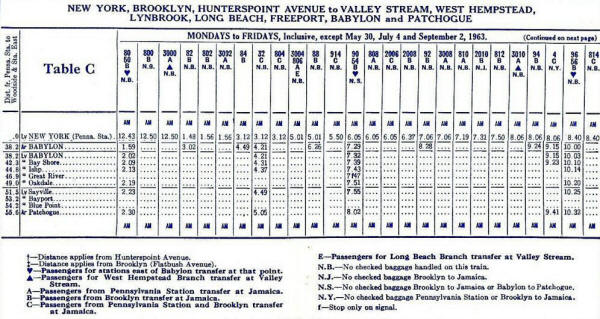 Babylon-Patchogue Scoot Morning Timetable 5/19/1963 |
||||||||||
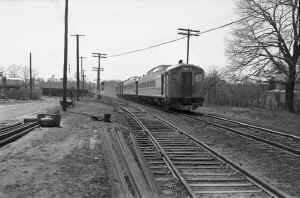 Budd RDCs 1 & 2 heading eastbound past Underwood Fuel with RPO car in tow, approaching River Avenue, Patchogue. 4/06/1963 Photo: William Lichtenstern |
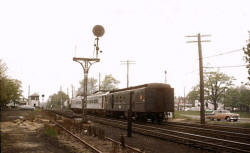 RDC's with trailer westbound approaching PD Tower, Patchogue 1956 (Huneke-Keller) |
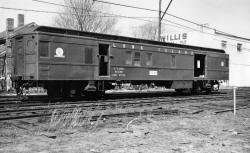 BM62 #7743 Patchogue view NE 4/06/1963 Photo: Bill Lichtenstern Archive: Mike Boland "Set out" at Willis Tile for return westbound. |
|||||||||
|
The Saturday afternoon Babylon-Patchogue “Scoot” consisting of BUDD RDC1 #3101 and RDC2 #3121 coupled, is heading eastbound near River Ave. crossing as it approaches Patchogue on April 6, 1963. In tow is RPO (Railway Post Office) car BM62 #7743. As an aside, this towing of non-BUDD cars caused the BUDD Co. to void its warranty on these cars with the LIRR. At the left is Underwood Coal & Coke and in the foreground is the Ringhouse Siding, which extended all the way from west of the Underwood siding eastward to the west side of the Railroad Ave. crossing (after a 1949 track rearrangement) and had a capacity of 35 cars. One month later, demolition of the old Patchogue terminal and engine repair facilities would begin. |
|||||||||||
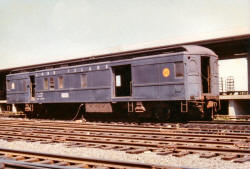 BM62 #7743 at the Richmond Hill Mail Loading Dock early 1960's Photo: Henry Maywald Archive: Mike Boland |
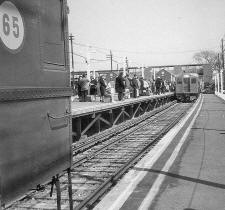 RDC Scoot picking-up RPO #65 at Babylon Winter View W 1963 Photo/Archive: Brad Phillips |
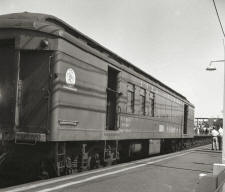 RPO #7751 Babylon temporary station - Scoot pickup 9/28/1963 (Faxon-Keller) |
|||||||||
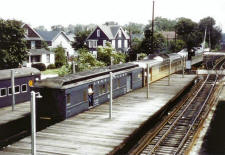 In the early 1960's, at Babylon Station, the "Scoot" to Patchogue has coupled to BM62B #7743 for its run east after it was set out from the MU train that delivered it. Photo: Malcolm Young Archive: Mike Boland |
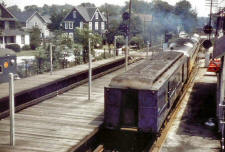 Babylon-Patchogue Scoot with RPO #7743 View E 1960's Photo: Malcolm Young Archive: Mike Boland
|
||||||||||
|
|
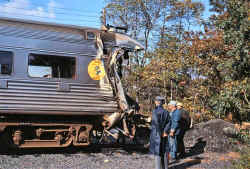 BUDD RDC Wreck - Holtsville 1967 |
||||||||||
|
The "Nappanee" was acquired by the LIRR from the B&O in October, 1968, per Jack Deasy's LIRR Parlor Car site. The "Nappanee" was renamed "Amagansett." Research: Dave Keller |
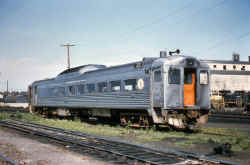 BUDD RDC2 #312 Jersey City, NJ 7/08/1968 Archive: Dave Keller |
||||||||||
|
|
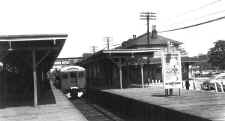 RDC1-2 Babylon 1955 W. J. Edwards photo, Dave Keller archive |
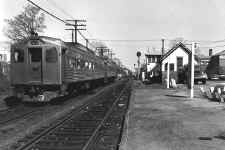 RDC at Patchogue Baggage House 4/06/1963 Archive: Dave Keller |
|||||||||
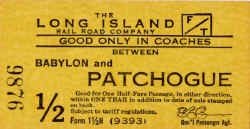 Scoot Ticket?? Babylon-Patchogue
GPA: Comer WW II era
Archive: Brad Phillips Scoot Ticket?? Babylon-Patchogue
GPA: Comer WW II era
Archive: Brad Phillips
As for tickets from the "Scoot",
that will be difficult to determine:
The only way to identify it as a "Scoot" ticket would be for it to be issued at Patchogue to Babylon or Babylon to Patchogue. . . and even THAT isn't conclusive as being used on the Scoot, because a rider COULD have purchased a ticket at Patchogue to Babylon or Babylon to Patchogue and got on a Montauk or Speonk train as well. . . . All Montauk and Speonk trains stopped at Babylon AND Patchogue except for the all-parlor Tickets didn't have train numbers on them, so without a train number you could never tell whether it was used on the Scoot or not, unless your PERSONALLY purchased the ticket and PERSONALLY rode the Scoot, in which case it would be YOUR ride on the Scoot, but there's nothing on the ticket to designate it as such other than identifying the ticket collector's punch design and seeing if that collector worked the Scoot that day . . . impossible for anyone to do other than the LIRR who has or had a record of all ticket punch identification designs. How long they kept them after collectors, brakemen, trainmen and conductors retired/left LIRR service is not known to me. Research: Dave Keller |
|||||||||||
|
|
|||||||||||
|
May 25, 1971 LIRR places first push-pull train in service on diesel lines; equipment consists of 44 former MP72 MU cars converted to T72 trailers with 6 converted Alco FA or EMD F units as control cabs on rear ends; cab units are unpowered and merely provide control cabs and head-end generators for lighting and heat. (PRR Keystone, Trains, MTA) The first run of a Push-Pull Train on the Montauk Branch in Passenger Service was on May 27th, 1971 with FA #601, 8 coaches and a C420 (L-2) on Train #66. The first train of a push-pull consist was comprised of ONLY ex-T72 cars, since they were easier to modify and did not need their motors to be removed as they didn't have any. RS3's started working the Push-Pull trains in the Summer of 1971 as well as the C420 L-1's. Early on in the 1971 transition, the FA (PC-6) units were on the EAST end of the train and the RS3s on the WEST end of the train, long-nose forward. On the Main line, at Ronkonkoma, this EAST end arrangement was also utilized. At this time the FA's was not used as a Cab Control Car, therefore the engines would run around the train. After operating in this manner for a short period of time, in late June 1971, the FA units were moved to the west end of the trains for servicing reasons, and they remained there until withdrawn from service and removed from the property. Delivered GP38-2 (1976-77) did not have head end power to supply passenger consists and only some MP15AC (3/1977) engines were equipped. Utilizing FA control cabs provided both class of engines with this requirement. FA’s had their traction motors removed and the ALCO 244 prime mover was used as Head End Power (HEP) for supply to the P72’s. The prime mover on the FA’s were kept at notch 4. The last units that had their stems generators used were the C420’s. FA's supplied 650v DC HEP for PT-72 and PT-75 cars to simulate 3rd rail for converted MU's with motor alternators. Steam heat on the P72's (2900's) was gone by early 1979, converted cars temporarily stenciled "electric heat" in black lettering next to the doors. FA unit conversions provided the engine crew the front-end protection that they wanted along with the 650V DC power from the converted prime mover hence their nicknames "Power Packs". These engines were rebuilt by General Electric in North Bergen NJ to provide constant 650V hotel power and cab controls only, thus they had no traction motors. Mike Boland The Zip
Cars were converted to Push-Pull Service early to mid-1972. |
|||||||||||
|
LIRR Instruction Booklet for Push-Pull Trains August 1971 |
|||||||||||
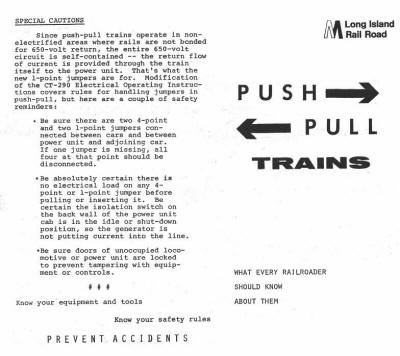 |
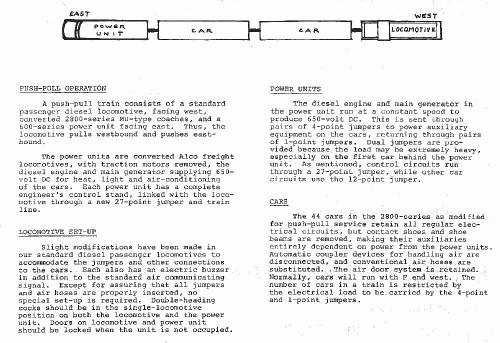 MTA/LIRR Push-Pull Trains 8/1971 - Archive: Mike Boland |
||||||||||
|
PUSH-PULL TRAIN OPERATION SPECIAL CAUTIONS The original push-pull concept was a success and would be used for around 30 years in LIRR service from 1971 to 2000. More former MU cars and other locomotives would be later converted over time for train service. Material courtesy of Mike McEnaney |
|||||||||||
|
|
|||||||||||
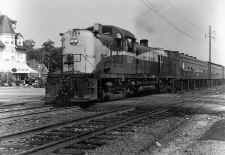 RS3 #1554 Scoot Islip 1969 Archive: Dave Keller |
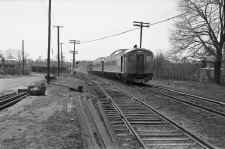 RDC1-2 RPO Car at River Ave, Patchogue 4/06/1963 Archive: Dave Keller |
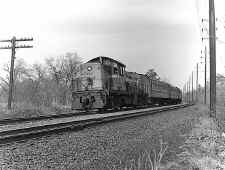 RS1 462 Babylon-Patchogue Scoot westbound near Great River 1968 (J. P. Krzenski-Dave Keller) |
|||||||||
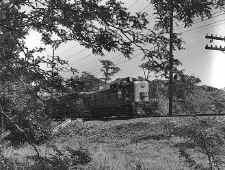 RS3 1553 Babylon-Patchogue Scoot Westbound near Great River -1968 (J. P. Krzenski-Dave Keller) |
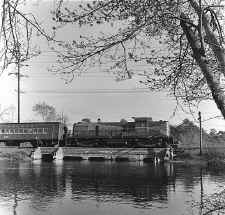 RS3 1553 Babylon-Patchogue Scoot Crossing Creek WB west of Oakdale-1968 (J. P. Krzenski-Dave Keller) |
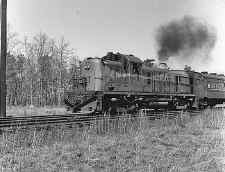 RS3 1552 Babylon-Patchogue Scoot westbound west of Oakdale-1969 - (J. P. Krzenski-Dave Keller) |
|||||||||
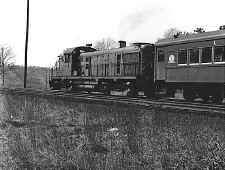 RS3 1552 Babylon-Patchogue Scoot west leaving Great River-1969 (J. P. Krzenski-Dave Keller) |
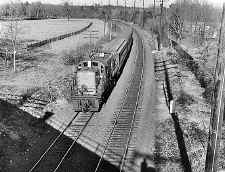 RS3-1554 Babylon-Patchogue Scoot westbound at Montauk Hwy 1969 Overpass-W of Oakdale (J. P. Krzenski-Dave Keller) |
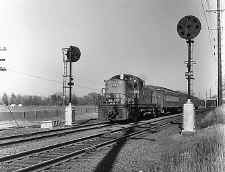 RS3 1554 Babylon-Patchogue Scoot westbound past signals east of Great River 1969 (J. P. Krzenski-Dave Keller) |
|||||||||
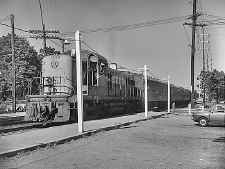 RS3 1555 Babylon-Patchogue Scoot westbound approaching Great River 1969 (J. P. Krzenski-Dave Keller) |
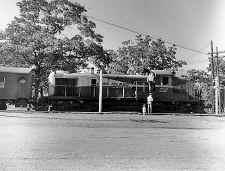 RS3-1556 Babylon-Patchogue Scoot broken down eastbound at Great River-1969 (J. P. Krzenski-Dave Keller) |
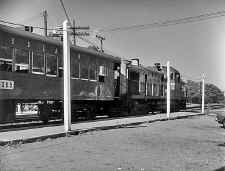 RS3 1556 Babylon-Patchogue Scoot broken down Eastbound at Great River 1969 (J. P. Krzenski-Dave Keller) |
|||||||||
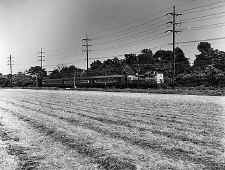 RS3 Babylon-Patchogue Scoot westbound through field east of Great River 1969 (J. P. Krzenski-Dave Keller) |
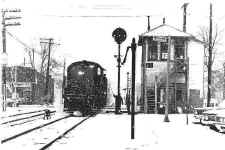 Winter 1970 at PD Tower with LIRR RS-3 #1559 Westbound Archive: Dave Keller |
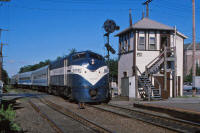 Scoot LIRR #620 Train #57 leaves the School House Track at PD Interlocking. The "Scoot" will pick up its passengers in Patchogue station, and proceed west to Babylon. 6/1989 Photo/Archive: Jay Bendersky |
|||||||||
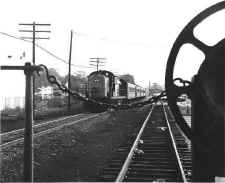 PD LIRR #1553 Hack view E 1972 Dave Keller photo and archive |
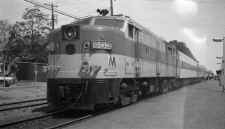 An updated view of the Babylon-Patchogue Scoot is shown here with FA2 control cab #603 on the west end of westbound train #63 at the station in Patchogue, NY – 8/17/76. GP38-2 #257 is on the east and powered end preparing to push the train to Babylon. (George E. Votava photo - Dave Keller archive) |
||||||||||
 |
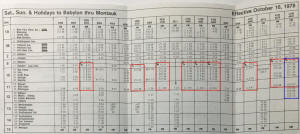 Eastern Long Island timetable Scoot Sat-Sun, Holidays Eastbound  Eastern Long Island timetable Scoot Sat-Sun, Holidays Westbound 10/16/1978 Archive: RMLI |
 Eastern Long Island timetable Scoot Mon-Fri east/westbound 10/16/1978 Archive: RMLI |
|||||||||
|
|
|
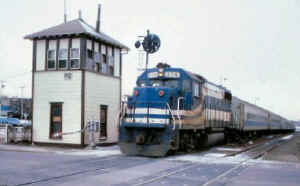 GP38-2 #274 2/11/1986 Photo: Tom Beckett |
|||||||||
 Babylon to Patchogue Official Training maps 1/1978 |
|||||||||||
 Babylon to Patchogue Interlocking maps c.1988 |
|||||||||||
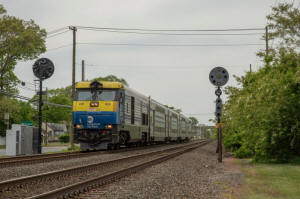 |
Babylon-Patchogue Scoot #74, led by DE30AC 419 splits the signals right on the border of the Villages of West Islip and West Bay Shore. On the right is Babylon’s “hold-out” home signal #60. Other than the Oyster Bay Branch, the segment from Babylon to Y, east of Sayville, is a “251” holdout. The last of the wayside automatic block signals. 5/19/2023 Info/Photo/Archive: Jeff Erlitz |
|
|||||||||
|
|
|||||||||||
| Ronkonkoma-Hicksville Shuttle | |||||||||||
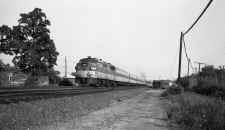
ALCO FA1 control cab
#616 is seen on push-pull train #255 in Ronkonkoma-Hicksville shuttle service at Bethpage, NY (George E. Votava photo- Dave Keller captions/archive)
|
 Shuttle Sat-Sun - Ronkonkoma-Hicksville 5/20/1974 Archive: RMLI |
||||||||||
|
This shuttle ran to meet Main Line-bound
riders arriving on electric trains bound for Huntington on the Port
Jefferson branch and changing for the shuttle at Hicksville or taking
westbound riders from Ronkonkoma and other Main Line stations to Hicksville
to connect with the electric train there which originated at Huntington.
The diesel train would arrive on the track across from the electric trains.
This shuttle service ended with the electrification of the Main Line
to Ronkonkoma and the operation of through electric service.
Photo: George E. Votava Research/Archive: Dave Keller |
|||||||||||
| Huntington-Port Jefferson Shuttle | |||||||||||
|
|
 Shuttle Sat-Sun - Huntington-Port Jefferson 5/20/1974 Archive: RMLI |
||||||||||
|
Photo: George E. Votava Research/Archive: Dave Keller |
|||||||||||
| Valley Stream-West Hempstead Shuttle | |||||||||||
|
|
 Shuttle Sat-Sun - Valley Stream-West Hempstead 5/20/1974 Archive: RMLI |
||||||||||
| Salisbury Plains (Mitchel Field) Shuttle | |||||||||||
|
|
|||||||||||
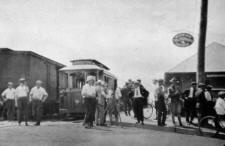 The Central branch between "HC" (Hempstead Crossing) in
Garden City and Salisbury Plains was electrified in 1917. That
year, 3 ex-Ocean Electric trolley cars were converted from trolley to
third rail service and operated as a shuttle (one car at a time) between a
layup track opposite the Garden City station and Salisbury Plains, making
a stop at Mitchel Field (yes, "Mitchel" with one "L"). This shuttle ran
until 1927. The Central branch between "HC" (Hempstead Crossing) in
Garden City and Salisbury Plains was electrified in 1917. That
year, 3 ex-Ocean Electric trolley cars were converted from trolley to
third rail service and operated as a shuttle (one car at a time) between a
layup track opposite the Garden City station and Salisbury Plains, making
a stop at Mitchel Field (yes, "Mitchel" with one "L"). This shuttle ran
until 1927. On 10/31/1927, the shuttle was moved to a layup track at Country Life Press and all shuttle service then operated between there and Salisbury Plains. In 1928 the Ocean Electric cars were withdrawn from service and replaced at first by one MP41 MU car, then two MP41 MU cars (2-car train), and finally, two MP54 MU cars (2-car train) Service was cut back to Mitchel Field during WWII, because the trip to Salisbury Plains ran through secure government territory. The field was fenced off and trains /ex-trolleys were no longer allowed to run past Mitchel Field station so Salisbury Plains station was closed. The last passenger shuttle trip ran between CLP and Mitchel Field on 5/15/53. Research: Dave Keller Photo: Ocean Electric
Car #29 at Clinton Road, Garden City 1918 Archive: Dave Keller
MORE:
Salisbury Plains Shuttle |
|||||||||||
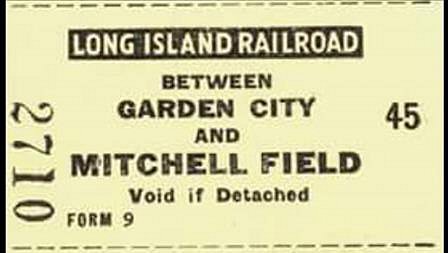 In the last years of shuttle service, tickets were NOT
sold. Riders paid cash. I believe the fare was $ .25. On-train tickets
were not issued. . . it was simply hand the trainman or conductor a
quarter and I believe it was the same whether you went to Mitchel Field or
closer stops like Newsday and A&P Bronze (since 6/1949). In the last years of shuttle service, tickets were NOT
sold. Riders paid cash. I believe the fare was $ .25. On-train tickets
were not issued. . . it was simply hand the trainman or conductor a
quarter and I believe it was the same whether you went to Mitchel Field or
closer stops like Newsday and A&P Bronze (since 6/1949).
This ticket, from a monthly ticket book, is printed Garden City to "Mitchell" Field
(incorrect as it's
"Mitchel" field . . . one "L"). This was not the end of the line in the
1917-1927 years of operation. It was but one of several stops on the way
to the truncated branch at Salisbury Plains. This ticket would have been
issued at the Garden City station anytime between 1917 and 1927. Riders
would have walked across the tracks at Garden City and got on the
ex-trolley car to Mitchel Field and/or Salisbury Plains. |
|||||||||||
_small.jpg) MP41 #1100-1101
- Mitchel Field Shuttle at Clinton Rd. Station View NE
3/25/1947 MP41 #1100-1101
- Mitchel Field Shuttle at Clinton Rd. Station View NE
3/25/1947
Photo: Edward Hermanns |
 MP41 #1100-1101 - Mitchel Field Shuttle north of Country Life Press.
View
SE 3/30/1947 MP41 #1100-1101 - Mitchel Field Shuttle north of Country Life Press.
View
SE 3/30/1947
Photo: Edward Hermanns Archive: Dave Keller |
||||||||||
 After practically all of the MP41 MU cars were taken out
of passenger service, the last few were used on the shuttle. They, too,
were eventually withdrawn from service and were replaced by two MP54 MU
cars. Here's a peaceful view from the summer of 1949 with puffy,
fair-weather clouds in the sky looking NE. It shows the 2-car shuttle of
MP54 MU cars consisting of car #s 1762 and 1943, coupled, and laying up on
the truncated segment of the former Mineola to Hempstead track. Note both
cars are in the PRR Tuscan Red color scheme with Dulux gold lettering and
the car at right has what appears to be an aluminum-painted roof, designed
to reduce the summer's heat in the car. The rail visible at the very
bottom of this image is that of the Hempstead branch between Garden City
and the terminal at Hempstead. After practically all of the MP41 MU cars were taken out
of passenger service, the last few were used on the shuttle. They, too,
were eventually withdrawn from service and were replaced by two MP54 MU
cars. Here's a peaceful view from the summer of 1949 with puffy,
fair-weather clouds in the sky looking NE. It shows the 2-car shuttle of
MP54 MU cars consisting of car #s 1762 and 1943, coupled, and laying up on
the truncated segment of the former Mineola to Hempstead track. Note both
cars are in the PRR Tuscan Red color scheme with Dulux gold lettering and
the car at right has what appears to be an aluminum-painted roof, designed
to reduce the summer's heat in the car. The rail visible at the very
bottom of this image is that of the Hempstead branch between Garden City
and the terminal at Hempstead. Photo: W. J. Edwards Archive: Dave Keller archive |
|||||||||||
_small.jpg) MP41 #1100 as Mitchel Field one-car shuttle at the shuttle lay-up track just north of the Country Life Press station. View is NE. The old CRR of LI brick water tower at Hempstead Crossing is visible in the left background and the main through-track to and from Hempstead Crossing is in the foreground - c. 1933 Photo: George Arnoux Archive: Dave Keller |
|
||||||||||
11/21/2025